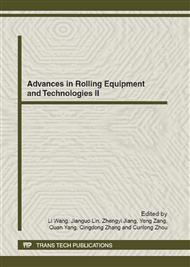p.61
p.67
p.72
p.78
p.82
p.88
p.94
p.98
p.104
Study on the Relationship between Chatter Mark Vibration and Rolling Skid for a Twenty-High Roll Mill Based on the Measured Torsional Strain of the Main Drive Shaft
Abstract:
The chatter mark vibration generated in the rolling process of the twenty-high roll mill not only significantly affects the mill performance, but also reduces surface quality of the strip steel. To identify the excitation source, the online monitor for the real time torsional strain of the main drive shaft is performed for a Sendzimir twenty-high roll mill. A corresponding relationship between the torsion variation of the main drive shaft and the period variation of the working roller is observed. The dynamic rolling skid model is further established and the torsion variation of the main drive shaft is simulated. The calculated results are compared with the measured torsion variation signal of the main drive shaft for without chatter mark vibration. The corresponding characteristics between the chatter mark vibration and the rolling skid is obtained. The results not only support the effective of the established model, but also reveal the relationship between the chatter mark vibration and the rolling skid, which provides for the development of monitoring method for the chatter mark vibration of the twenty-high roll mill.
Info:
Periodical:
Pages:
82-87
Citation:
Online since:
October 2012
Authors:
Price:
Сopyright:
© 2012 Trans Tech Publications Ltd. All Rights Reserved
Share:
Citation:


